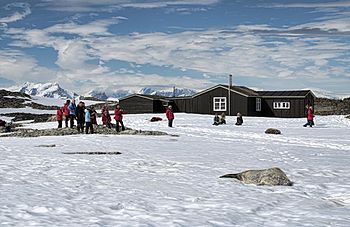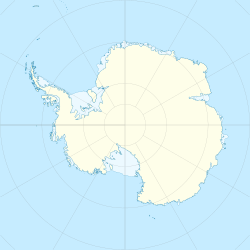Argentine Islands facts for kids

Wordie House, photographed in 2013
|
|
|
Location in Antarctica
|
|
| Geography | |
|---|---|
| Location | Antarctica |
| Coordinates | 65°15′S 64°16′W / 65.250°S 64.267°W |
| Administration | |
| Administered under the Antarctic Treaty System | |
The Argentine Islands are a group of small islands in Antarctica. They are part of the Wilhelm Archipelago. These islands are about 9 kilometers (5 nautical miles) southwest of Petermann Island. They are also about 7 kilometers (4 nautical miles) northwest of Cape Tuxen. This cape is on the Kiev Peninsula in Graham Land.
A French team discovered these islands. This happened during the French Antarctic Expedition, 1903–05. The expedition was led by Jean-Baptiste Charcot. He named the islands after the Argentine Republic. This was to thank the Argentine government for helping his expedition.
Contents
Exploring the Argentine Islands
Early Expeditions and Bases
The British Graham Land Expedition explored the Argentine Islands in 1935. This team was led by John Riddoch Rymill. They made a very detailed map of the islands.
The expedition built a small hut on Winter Island. This hut was their main base in the northern area. They left the hut there after their work finished. However, it was destroyed around 1946.
A few years later, in 1946, a British group built a new base. This was the Falkland Islands Dependencies Survey. They set up a permanent base in the same spot. It was called "Base F" or "Argentine Islands". The main building from this base is called Wordie House. Today, Wordie House is a protected historic site. It is known as HSM-61.
In 1954, the base moved to Galindez Island. It was later renamed "Faraday" in 1977. In 1996, the base was given to the Ukrainian Antarctic program. They still use it today as the Vernadsky Research Base.
Weather on the Islands
Understanding the Climate
The Argentine Islands have a polar climate. This means it is very cold there. The climate is a mix between an ice cap climate and a tundra climate. It's unusual because it's on the ocean but feels more like a land climate. This is because the ocean around it is often frozen.
| Climate data for Argentine Islands | |||||||||||||
|---|---|---|---|---|---|---|---|---|---|---|---|---|---|
| Month | Jan | Feb | Mar | Apr | May | Jun | Jul | Aug | Sep | Oct | Nov | Dec | Year |
| Record high °C (°F) | 7.8 (46.0) |
8.3 (46.9) |
7.8 (46.0) |
7.2 (45.0) |
6.1 (43.0) |
4.4 (39.9) |
3.9 (39.0) |
7.2 (45.0) |
5.0 (41.0) |
5.6 (42.1) |
5.0 (41.0) |
6.1 (43.0) |
8.3 (46.9) |
| Mean daily maximum °C (°F) | 2.2 (36.0) |
1.7 (35.1) |
1.1 (34.0) |
−1.7 (28.9) |
−5.0 (23.0) |
−6.1 (21.0) |
−7.2 (19.0) |
−7.8 (18.0) |
−6.1 (21.0) |
−2.2 (28.0) |
−0.6 (30.9) |
1.7 (35.1) |
−2.5 (27.5) |
| Daily mean °C (°F) | 0.3 (32.5) |
−0.3 (31.5) |
−0.8 (30.6) |
−3.6 (25.5) |
−7.5 (18.5) |
−9.2 (15.4) |
−10.6 (12.9) |
−11.7 (10.9) |
−10.0 (14.0) |
−5.6 (21.9) |
−3.6 (25.5) |
−0.6 (30.9) |
−5.3 (22.5) |
| Mean daily minimum °C (°F) | −1.7 (28.9) |
−2.2 (28.0) |
−2.8 (27.0) |
−5.6 (21.9) |
−10.0 (14.0) |
−12.2 (10.0) |
−13.9 (7.0) |
−15.6 (3.9) |
−13.9 (7.0) |
−8.9 (16.0) |
−6.7 (19.9) |
−2.8 (27.0) |
−8.0 (17.6) |
| Record low °C (°F) | −8.3 (17.1) |
−8.9 (16.0) |
−12.8 (9.0) |
−16.7 (1.9) |
−29.4 (−20.9) |
−33.9 (−29.0) |
−36.1 (−33.0) |
−36.1 (−33.0) |
−38.9 (−38.0) |
−27.8 (−18.0) |
−22.2 (−8.0) |
−10.6 (12.9) |
−38.9 (−38.0) |
| Average precipitation mm (inches) | 22.9 (0.90) |
73.7 (2.90) |
50.8 (2.00) |
71.1 (2.80) |
20.3 (0.80) |
33.0 (1.30) |
22.9 (0.90) |
27.9 (1.10) |
53.3 (2.10) |
25.4 (1.00) |
10.2 (0.40) |
48.3 (1.90) |
460.0 (18.11) |
| Source: Sistema de Clasificación Bioclimática Mundial | |||||||||||||
Islands in the Group
Here are some of the islands that make up the Argentine Islands group:
See also
 In Spanish: Islas Argentina para niños
In Spanish: Islas Argentina para niños


